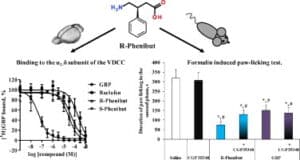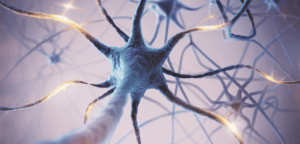Phenibut's Mechanism of Action
Phenibut is a Russian neuropsychotropic drug that was discovered in 1959. It has the chemical name β-phenyl-γ-aminobutyric acid (GABA).
It is available in powder and capsule variants. It has anxiolytic and cognitive-enhancing qualities.
It works as a GABA- mimic, with the primary effect being at GABA G receptors. It also activates dopamine and inhibits β-phenylethylamine, which is considered to be an endogenous anxiogenic by some.
Phenibut is a popular nootropic in Russia that is used to treat tension, anxiety, and dread as well as insomnia in people who don't have an underlying psychological or physiological condition.
It's also used before and after surgery as a pre-or post-operative therapy.
It is employed in the treatment of asthenia and insomnia as well as anxiety and pain.
Overview
Phenibut has been marketed under a variety of names including Anvifen, Fenibut, and Noofen.
It is a central nervous system depressant that is used in Russia, Ukraine, and Latvia to treat anxiety, sleeplessness, and a range of other problems.
It is not authorized for clinical usage in the United States and most of Europe, although it has been available over the internet as a nootropic.
Phenibut is a GABA analog because it is structurally linked to the neurotransmitter γ-aminobutyric acid (GABA).
It has been reported to act on the GABAB receptors, just like baclofen and γ-hydroxybutyrate (GHB).
It has been discovered that it inhibits subunit-containing voltage-dependent calcium channels (VDCCs) and has a comparable function to gabapentinoids such as gabapentin and pregabalin, following several studies.
Phenibut, often marketed as b-phenyl-GABA or phenyl-GABA, is a GABAB agonist developed in the Soviet Union in the 60s that's used to treat a range of ailments, including:
- Sleeplessness
- Anxiety
- Sadness
- Insomnia
The quantity of its usage, safety profile, and societal and medical cost associated with such Nootropic is unknown. Phenibut withdrawal has only been documented once.
New psychoactive substances (NPS) have lately experienced a resurgence in popularity and usage, have been popular since the 90s.
A psychotropic drug, psychopharmaceutical, or psychotropic is a chemical substance that alters human brain activity and causes modifications in perception, mood, and consciousness.
The psychoactive chemicals have a few major purposes. It has the ability to function as an anesthetic. It may also aid in the relief of pain.
Structure and Analogs


Phenibut is a GABA derivative. As a result, it's a GABA analog. Phenibut is the α-position phenyl analog of GABA, specifically when the β-position contains a phenyl ring.
It is one of the most common neurotransmitters in the human brain, but it also has numerous other names. Its chemical name is β-phenyl-GABA, which may be shortened to β-phenyl-GABA. Because of its phenyl ring, phenibut can easily cross the blood-brain barrier, unlike GABA.
Phenibut is a GABA analog that is closely related to a number of other GABA-related compounds, including:
- Baclofen (β-(4-chlorophenyl)-GABA)
- 4-fluorophenibut (β-(4-fluorophenyl)-GABA)
- Tolibut (β-(4-methylphenyl)-GABA)
- Gabapentin (1-(aminomethyl)cyclohexane acetic acid)
- GABOB (β-hydroxy-GABA)
It is structurally similar to baclofen, with the exception that it has a hydrogen atom in place of a chlorine atom at a different position in the phenyl ring.
Phenibut is structurally similar to pregabalin, which contains an isobutyl group at the β-position rather than a phenyl ring.
Phenibut's Mechanism of Action


Phenibut, as a full agonist of the GABAB receptor, has 30 to 68 times lower binding affinity for the GABAB receptor than baclofen. In agreement with this, phenibut is utilized at considerably lower dosages in comparison.
The GABAB receptor is activated by (S)-phenibut and its functional enantiomer, (R)-phenibut. Although the affinity for the GABAB receptor of (R)-Phenibut is more than 100-fold greater than that of (S)-phenibut because it has a higher affinity for the GABAB receptor.
In high dosages, it has been reported to act as an agonist of the GABAA receptor, which is the benzodiazepine receptor that is responsible for the actions of barbiturates and alcohol.
The α2δ subunit-containing VDCCs are also blocked by phenibut. Because it works similarly to gabapentin and pregabalin, it has a similar affinity for the gabapentinoid action (Ki = 23 and 39 μM, respectively).
Furthermore, (R)-phenibut binds significantly stronger to this site than the GABAB receptor, which is Ki = 92 μM. (S) Phenibut does not bind significantly to the GABAB receptor, which is Ki > 1 mM.)
Phenibut's effects on α2δ subunit-containing VDCCs are likely to be far greater than its interactions with the GABAB receptor, which is in the range of 5 and 10 fold.
Because of this, the effects of phenibut as an α2δ subunit-containing voltage-gated calcium channel blocker or gabapentinoid may be its main mechanism of action.
This may help to explain the distinction between phenibut and its cousin baclofen, which, in contrast, has a minimal gabapentinoid effect.
Pharmacokinetics
Phenibut has very limited clinical pharmacokinetic data. The drug is said to be well absorbed. It slowly spreads throughout the body and across the blood-brain barrier.
The majority of a substance's volume is removed from the brain after absorption. Phenibut penetrates into the brain at approximately 0.1 percent of an administered dose, according to researchers.
Its elimination half-life was just over 5.3 hours after a single 250 mg dose in healthy individuals, and the drug was mostly (63%) excreted unchanged in the urine.
The absolute bioavailability of phenibut in animals was 64% after oral and intravenous administration.
It appears to be metabolized at extremely low levels or not at all in several species, and it has a much greater capacity to cross the blood-brain barrier than GABA.
There is some limited data on the pharmacokinetics of phenibut in recreational users who have taken much higher doses (e.g., 1–3 g) than typical clinical doses.
The onset of action of phenibut in these people has been reported as 2-4 hours orally and 20-30 minutes rectally.
The peak effects are said to appear 4–6 hours after oral consumption, and the entire oral method is thought to take 15–24 hours or roughly 3–5 half-lives.
Phenibut's Functions in The Brain
Phenibut has a lot of positive qualities.
It has been clinically shown to both enhance mood and improve cognitive function in a number of ways. These include:
Brain Function
Phenibut has been shown to enhance cognitive abilities and mental performance in a few small studies.
According to several studies, taking phenibut improved brain function, especially communication between the hemispheres of the brain.
Mood-Boosting
The major advantage of phenibut is that it improves mood.
It's quite effective in elevating spirits and producing feelings similar to those produced by taking a large dose of piracetam with a low dose of codeine.
Stress
Phenibut is a powerful anxiolytic drug that calms people down. It works to decrease anxiety in your brain by acting on the central nervous system.
It accomplishes this by stimulating the person's GABA receptors, which generate a sense of mental calmness while also lowering stress.
Anyone who has ever been stressed knows that being stressed cannot simply be "turned off." Phenibut, on the other hand, may provide the closest thing to an "anti-stress" button.
Learning and Cognition
It has a better capacity for problem-solving and creative thinking. Phenibut may provide further aid to memory and learning.
Phenibut may also aid in the improvement of cognitive function. Many individuals are unaware that phenibut is a nootropic substance.
It has been demonstrated to enhance brain function, but it has not been shown to substantially improve cognition when compared to racetams, smart drugs, and other more powerful nootropics.
Phenibut has also shown cognitive advantages in a few studies, and it may aid communication between two brain hemispheres while also improving problem-solving abilities.
Insomnia
Phenibut can be used to cure insomnia in individuals who are having issues sleeping. It improves the quality of sleep and makes it simpler for the individual to nod off.
Phenibut can be a sort of sleeping pill that will help you relax.
If you've been having trouble falling asleep and feeling rested, phenibut might be your new best buddy. Phenibut is well-known for its capacity to promote a night of deep, restful sleep.
Neuroprotection
Phenibut has neuroprotective effects. Phenibut protects brain cells from damage.
When we are anxious, our neuron cells often suffer irreversible harm. Phenibut aids in the prevention of this damage.
Surprisingly, this same tension can also damage a person's heart ventricles, which means phenibut may assist enhance overall cardiac health.
Positive and Controlled Mood
Phenibut is used to relieve anxiety as well as other mood imbalances. It can also be used to promote a good and controlled mood.
If the individual is frequently irritable or angry, it might be caused by a chemical imbalance in the brain.
External stressors trigger these chemical imbalances, which are caused by high levels of stress hormones.
Phenibut boosts dopamine, counteracting the effects of these compounds and restoring balance to the person's mood.
This has also been linked to greater motivation.
Sources:
- https://jprsolutions.info
- https://www.sciencedirect.com/topics/pharmacology-toxicology-and-pharmaceutical-science/4-aminobutyric-acid-derivative
- https://www.webmd.com/vitamins/ai/ingredientmono-1184/phenibut
- https://pubmed.ncbi.nlm.nih.gov/5741045/
- https://pubmed.ncbi.nlm.nih.gov/11830761/
- https://pubmed.ncbi.nlm.nih.gov/661205/
- https://pubmed.ncbi.nlm.nih.gov/23075553/
- https://pubmed.ncbi.nlm.nih.gov/30852710/
- https://www.sciencedirect.com/science/article/abs/pii/S009130571530037X
